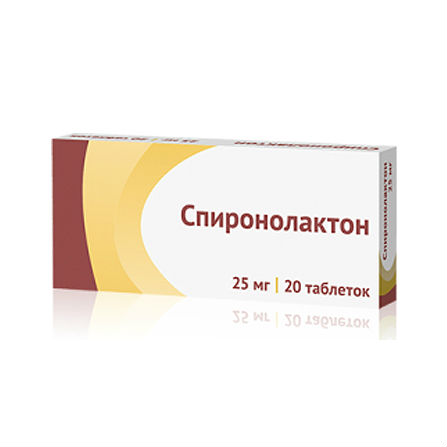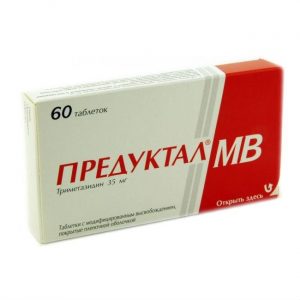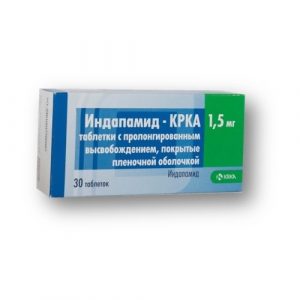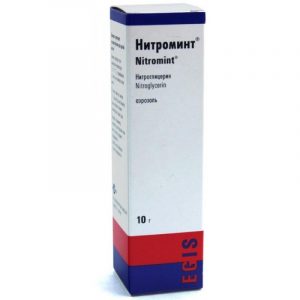Description
Pharmacological action
Potassium-, magnesium-sparing diuretic. It is a competitive antagonist of aldosterone in influencing the distal nephron (competes for binding sites on cytoplasmic protein receptors, reduces the synthesis of permeases in the aldosterone-dependent portion of the collecting tubules and distal tubules), increases the excretion of Na +, Cl- and water and reduces the excretion of K + and urea, and reduces the titratable acidity of urine. Increased diuresis causes a hypotensive effect, which is variable. The antihypertensive effect does not depend on the level of renin in the blood plasma and does not appear with normal blood pressure. The diuretic effect is manifested on 2-5 days of treatment.
Indications
Edema in chronic heart failure, cirrhosis of the liver (especially with the simultaneous presence of hypokalemia and hyperaldosteronism), with nephrotic syndrome. Edema in the II and III trimesters of pregnancy. Arterial hypertension, including with aldosterone-producing adrenal adenoma (as part of combination therapy). Primary hyperaldosteronism. Aldosterone-producing adrenal adenoma (long-term maintenance therapy in case of contraindication to surgical treatment or in case of refusal from it). Diagnosis of hyperaldosteronism. Hypokalemia and its prevention in the treatment of saluretics. Polycystic ovary syndrome, premenstrual syndrome.
Contraindications
Addison’s disease, hyperkalemia, hypercalcemia, hyponatremia, chronic renal failure, anuria, liver failure, diabetes mellitus with confirmed or suspected chronic renal failure, diabetic nephropathy, I trimester of pregnancy, metabolic acidosis, menstrual irregularities or enlarged mammary glands, hypersensitivity to spironolactone.
Recommendations for the use of
The method of use and the dosage regimen of a particular preparation depend on its form of release and other factors. The optimal dosage regimen is determined by the doctor. The compliance of the dosage form of a particular preparation with the indications for use and the dosage regimen should be strictly observed. Set individually depending on the severity of violations of water-electrolyte metabolism and hormonal status. With edematous syndrome – 100-200 mg / day (less often – 300 mg / day) in 2-3 doses (usually in combination with a loop or / and thiazide diuretic) daily for 14-21 days. Dose adjustment should be carried out taking into account the values of the concentration of potassium in the plasma. If necessary, the courses are repeated every 10-14 days. With severe hyperaldosteronism and a reduced plasma potassium content – 300 mg / day in 2-3 doses.
Special instructions
Use with caution in case of AV blockade (the possibility of amplification due to the development of hyperkalemia), decompensated liver cirrhosis, surgical interventions, taking medications, causing gynecomastia when taking local and general anesthetics in elderly patients. Against the background of the use of spironolactone, preparations containing potassium should not be prescribed, as well as other diuretic agents that cause a delay in potassium in the body. The use of spironolactone with carbenoxolone, which causes sodium retention, should be avoided. During the treatment period, periodic determination of the electrolyte and urea content in the blood should be carried out. When using spironolactone in combination with other diuretic or antihypertensive drugs, the dose of the latter is recommended to be reduced. When using spironolactone simultaneously with digoxin, it may be necessary to reduce both the saturating and the maintenance doses of the latter.
Composition
Tablets 1 tab. spironolactone 25 mg
Side effects of the
Digestive system: nausea, vomiting, abdominal pain, gastritis, ulceration and bleeding in the digestive tract, intestinal colic, diarrhea or constipation. From the side of the central nervous system: dizziness, drowsiness, lethargy, headache, lethargy, ataxia. On the part of the metabolism: increased urea concentration, hypercreatininemia, hyperuricemia, impaired water-salt metabolism and ASR (metabolic hypochloremic acidosis or alkalosis). From the hemopoietic system: megaloblastosis, agranulocytosis, thrombocytopenia. From the endocrine system: with prolonged use – gynecomastia, erectile dysfunction in men in women – dysmenorrhea, amenorrhea, menopause in menopause, hirsutism, coarsening of the voice, tenderness of the mammary glands, breast carcinoma. Allergic reactions: urticaria, maculopapular and erythematous rashes, drug fever, pruritus. Other: muscle cramps, decreased potency.
active substance
spironolactone
Terms of delivery from
pharmacies Prescription
dosage form
tablets




